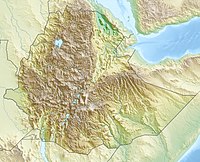Erta Ale: Difference between revisions
| Line 58: | Line 58: | ||
* {{fr icon}} [http://danakil.ethiopia.free.fr/ertaale.htm Photos of Erta Ale: Expedition Nov 2006] |
* {{fr icon}} [http://danakil.ethiopia.free.fr/ertaale.htm Photos of Erta Ale: Expedition Nov 2006] |
||
* [http://news.bbc.co.uk/1/hi/sci/tech/7950845.stm BBC article about Erta Ale] |
* [http://news.bbc.co.uk/1/hi/sci/tech/7950845.stm BBC article about Erta Ale] |
||
* [http://independent-travellers.com/ethiopia/danakil_depression/erta_ale_volcano/ Photos of Erta Ale: Feb. 2015] |
|||
[[Category:Active volcanoes]] |
[[Category:Active volcanoes]] |
||
Revision as of 07:20, 13 March 2015
| Erta Ale | |
|---|---|
 Erta Ale in May 2008 | |
| Highest point | |
| Elevation | 613 m (2,011 ft)[1] |
| Listing | List of volcanoes in Ethiopia |
| Geography | |
| Parent range | Erta Ale Range |
| Geology | |
| Mountain type | Shield volcano |
| Last eruption | 1967 to present[2] |
Erta Ale (or Ertale or Irta'ale) is a continuously active basaltic shield volcano in the Afar Region of northeastern Ethiopia. It is situated in the Afar Depression, a badland desert area spanning the border with Eritrea. Erta Ale is the most active volcano in Ethiopia.
Geology

Erta Ale is 613 metres (2,011 ft) high, with one or sometimes two active lava lakes at the summit which occasionally overflow on the south side of the volcano.[1] It is notable for holding the longest-existing lava lake, present since the early years of the twentieth century (1906). Volcanoes with lava lakes are very rare: there are only six in the world.[3]
Erta Ale means "smoking mountain" in the local Afar language and its southernmost pit is known locally as "the gateway to Hell". In 2009, it was mapped by a team from the BBC using three-dimensional laser techniques,[4] in order for the mapping team to maintain a distance and avoid the lakes' searingly hot temperatures.

Erta Ale is centered over the east African rift system, which is a triple junction setting whose movements are resulting in the formation of a pull apart basin or rift. The volcano comprises mainly Mafic material which has been brought up to the surface caused by unroofing of the mantle due to this rift formation. [citation needed]
Not much is known about Erta Ale, as the surrounding terrain is some of the most inhospitable on Earth and the native Afar people have a legendary reputation for viciousness towards outsiders; one travel guide recommends hiring "one or maybe two armed guards or police" to visit Erta Ale.[5] However, they welcomed and helped a team from BBC.[6] On January 16, 2012, a group of German, Austrian and Hungarian scientists/tourists was attacked at Erta Ale. Five scientists/tourists were killed, some taken as hostages and others wounded.[7] The Afar Revolutionary Democratic Unity Front (ARDUF) claimed responsibility for the attack[8] and released the two kidnapped tourists in March 2012.[9]
Eruptions

There was a major eruption on 25 September 2005 which killed 250 head of livestock and forced thousands of nearby residents to flee.[10] There was further lava flow in August 2007, forcing the evacuation of hundreds and leaving two missing.[11] An eruption on 4 November 2008 was reported by scientists at Addis Ababa University.[12]
In popular culture
The lava lake on Erta Ale was shown briefly during the 2010 movie Clash of the Titans during the journey sequence where Perseus travels to the underworld.
See also
References
- ^ a b "Erta Ale, Ethiopia". Volcano World. Retrieved 2007-08-08.
{{cite web}}: External link in|work= - ^ a b "Erta Ale". Global Volcanism Program. Smithsonian Institution. Retrieved 2009-02-22.
- ^ "Episode 1: The Horn of Africa". On the Volcanoes of the World. The Science Channel. Retrieved 24 December 2010.
{{cite episode}}: Cite has empty unknown parameter:|serieslink=(help) - ^ Hottest Place On Earth, Episode 2 at bbc.co.uk
- ^ Briggs, Philip; Blatt, Brian (2009). Ethiopia: the Bradt Travel Guide (Fifth ed.). Chalfont St Peter: Bradt Travel Guides. p. 313. ISBN 978-1-84162-284-2.
- ^ Staff writers (19 March 2009). "Inside the hottest place on Earth". BBC News. Retrieved 24 December 2010.
- ^ "Deadly attack on tourists at Erta Ale - further details: 5 dead, 4 abducted and 7 wounded". VolcanoDiscovery. 18 January 2012. Retrieved 26 October 2013.
- ^ "Erta Ale January (sic) 17 kidnapping - ARDUF claims responsability (sic), hostages said to be well". VolcanoDiscovery. 20 February 2012. Retrieved 26 October 2013.
- ^ "Kidnapped German tourists released (Erta Ale, Danakil, Ethiopia incident 17 Jan 2012)". VolcanoDiscovery. 6 March 2012. Retrieved 26 October 2013.
- ^ "Focus on Ethiopia, September 2005", UN-OCHA . Retrieved 25 February 2009.
- ^ "Fears after volcano in Ethiopia". BBC News. 2007-08-15. Retrieved 2007-08-15.
- ^ there was also one in 2009. "Volcano erupts in Ertale volcanic area of Afar Region", Ethiopian News Agency website . Retrieved 20 January 2010.

